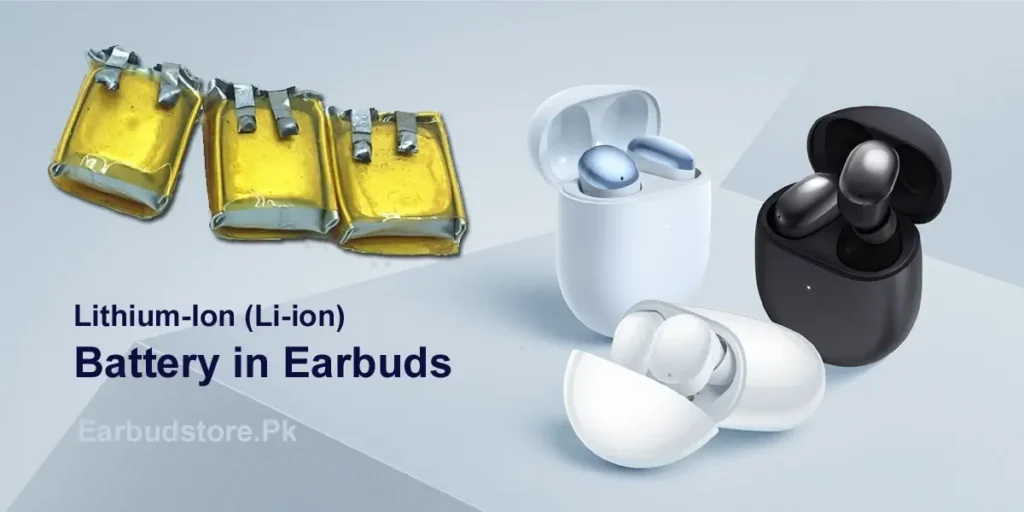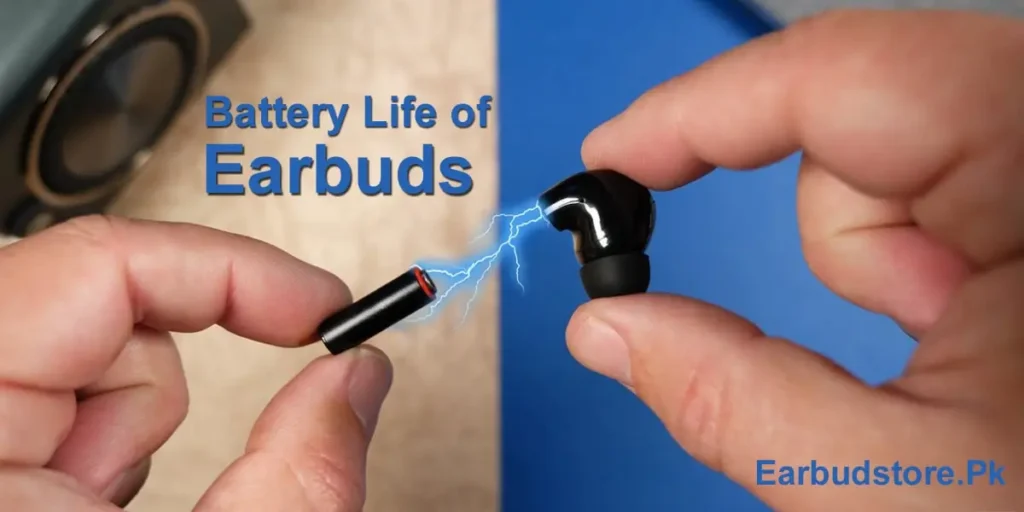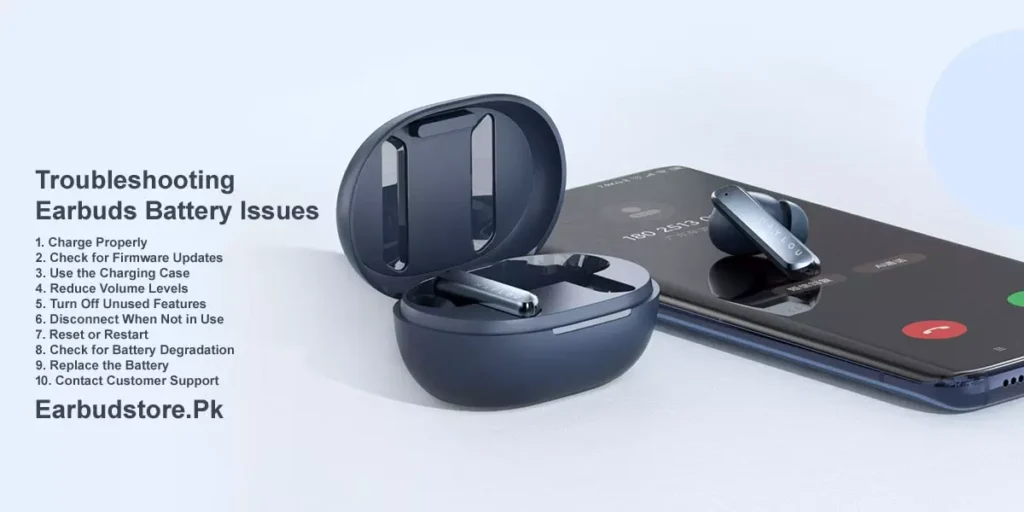Wireless earbuds seamlessly blend into daily life, offering cord-free audio with vital earbuds battery life, discussed for their types, longevity, charging, and environmental impact in this article.
Are you curious to delve into the intricacies and specifications of earbud batteries?
If your answer is a resounding yes, this article is meticulously designed to provide you with a thorough understanding of earbud batteries and how they are ingeniously incorporated into earbuds. Keep reading as we unravel the nuances of their mechanisms and the transformative influence, they wield in the audio landscape.
Be confident that this article is meticulously designed to equip you with an in-depth understanding of earbud batteries and their clever integration into earbuds. Our commitment is to uncover the intricate mechanisms and illuminate the transformative impact they have on the audio landscape as you continue reading.
Types of Earbuds Batteries
Earbuds are typically equipped with either lithium-ion (Li-ion) or lithium-polymer (LiPo) batteries. These batteries are chosen for their high energy density, lightweight design, and rechargeable properties.
Lithium-Ion (Li-ion) Battery in Earbuds

Lithium-ion batteries, often referred to as Li-ion batteries, have become the go-to choose for a wide array of portable electronic devices, including earbuds. Their popularity can be attributed to their remarkable energy density and relatively lightweight design. Li-ion batteries are known for striking a delicate balance between energy storage capacity and physical size, making them ideal for compact and lightweight earbud designs.
One of the key advantages of Li-ion batteries is their ability to store a substantial amount of energy in a small space. This high energy density is a critical factor in ensuring that earbuds can deliver long-lasting performance without compromising on their compact and streamlined form. Moreover, Li-ion batteries have a low self-discharge rate, meaning they retain their charge for a longer duration when not in use, providing convenience to users.
The chemistry of Li-ion batteries involves the movement of lithium ions between two electrodes (typically graphite and a metal oxide) during charging and discharging cycles. This movement of ions allows for efficient energy storage and release. Additionally, Li-ion batteries have a relatively low maintenance requirement, further enhancing their appeal for use in electronic devices like earbuds.
The utilization of lithium-ion batteries in earbuds guarantees a reliable and efficient power source, ensuring users can enjoy a seamless audio experience without the hassle of frequent recharging. As technology continues to advance, ongoing research and innovation in lithium-ion battery technology aim to further enhance their energy density, longevity, and overall safety, promising an even brighter future for battery-powered earbuds.
Lithium-Polymer (LiPo) Battery in Earbuds

Lithium-Polymer (LiPo) batteries represent a notable advancement in battery technology, exhibiting characteristics that set them apart from their Li-ion counterparts. While both LiPo and Li-ion batteries are part of the lithium-ion family and share similarities, LiPo batteries are distinctly more flexible in terms of shape and size. This unique flexibility stems from the composition and structure of LiPo batteries, allowing for a wider range of designs and configurations.
Compared to traditional Li-ion batteries, LiPo batteries can be manufactured in various shapes, from thin and flat to more intricate and three-dimensional designs. This pliability makes them particularly suitable for applications where space is limited or unconventional shapes are required. In the case of earbud technology, LiPo batteries offer a compelling advantage. The pliable nature of LiPo batteries enables manufacturers to design custom-shaped batteries that fit snugly within the compact and often irregularly shaped earbud cases. This is a significant departure from Li-ion batteries, which have limitations in terms of shape, making them less suitable for such specific form-fitting requirements.
Manufacturers can now tailor the battery to the available space within the earbud case, maximizing the use of internal space and ensuring an optimal fit. This customization enhances both the aesthetic design and functionality of earbuds. LiPo batteries, therefore, play a pivotal role in pushing the boundaries of modern earbud design, allowing for sleeker, more ergonomic earbuds that provide an enhanced user experience.
The distinct flexibility of LiPo batteries in terms of shape and size opens up exciting opportunities for innovative designs, especially in the realm of earbud technology. Manufacturers continue to leverage this flexibility to create increasingly compact, stylish, and functional earbuds that cater to the evolving needs and preferences of consumers.
Battery Life of Earbuds

Battery life stands as a pivotal aspect influencing the choice of earbuds for users, significantly impacting their overall experience. In the world of earbud technology, where portability and convenience are paramount, the duration of usage on a single charge is of utmost importance. A user’s ability to enjoy uninterrupted audio playback, engage in calls, or utilize various features without the interruption of constant recharging is directly tied to the earbuds’ battery life.
The battery life of earbuds is contingent upon multiple factors, including the earbud model, the efficiency of the battery technology employed, and the utilization patterns of the user. Different earbud models offer varying battery capacities, leading to differences in the duration of usage per charge. Some earbuds provide several hours of playtime, while others boast extended battery life, enabling usage for an entire day or more without requiring a recharge. This variability allows users to select earbuds that align with their specific needs and usage preferences.
Moreover, advancements in battery technology have led to improved power efficiency, extending battery life for earbuds. Manufacturers are continually investing in research and development to enhance battery performance, striving to strike the perfect balance between compact design and longer-lasting power. As technology evolves, we can anticipate further enhancements in earbud battery life, addressing a fundamental need for seamless, uninterrupted audio experiences on the go.
Factors Affecting Battery Life of Earbuds

The battery life of earbuds is influenced by multiple variables, encompassing both internal and external factors. Volume levels during usage significantly affect the battery life. Higher volume levels demand more power, consequently reducing the overall duration of usage per charge. Similarly, usage patterns play a crucial role. How frequently and for how long the earbuds are used impacts the battery life. Additionally, the efficiency of power management systems within the earbuds is instrumental in determining how effectively the battery is utilized, thus affecting the battery life.
Charging Methods:
Charging methods for earbuds have evolved to ensure a seamless and uninterrupted usage experience. The accompanying charging case plays a pivotal role in keeping the earbuds powered throughout the day. Various charging methods have been implemented to cater to different user preferences and needs:
- Wired Charging: A conventional and widely adopted method involves connecting the charging case to a power source using a USB cable. This method is straightforward, accessible, and ensures the earbuds are always ready for use.
- Wireless Charging: High-end earbuds and their respective cases often support wireless charging. Users can charge wireless earbuds by simply placing the case on a wireless charging pad. This method enhances convenience and eliminates the need for cables, providing a hassle-free charging experience.
- Fast Charging: To meet the demands of users with busy lifestyles, many modern earbuds offer fast-charging capabilities. A short charging period, often less than an hour, provides several hours of playback time. This feature caters to those who require quick recharges for immediate use, enhancing the practicality of using earbuds on the go.
Battery Health and Longevity
Maintaining the health and longevity of wireless earbud batteries is essential to ensure optimal performance over an extended period. Proper charging practices and appropriate usage habits can significantly contribute to preserving battery health:
- Proper Charging: Adhering to the manufacturer’s recommended charging guidelines is crucial for maintaining battery health. Overcharging or exposing the earbuds to extreme temperatures can expedite battery degradation. Following the specified charging times and intervals is essential.
- Usage Patterns: User behavior, specifically regarding usage patterns, can impact the overall battery life. Frequent deep discharges and exposure to high-temperature environments can lead to a shorter battery life. Avoiding extended periods of direct sunlight or leaving earbuds in hot environments can contribute to preserving battery efficiency.
Environmental Considerations
In an era where sustainability is paramount, it is equally vital to consider the environmental impact of electronic devices, including earbuds:
- Recycling: Responsible disposal of electronic waste, including earbuds and their batteries, is crucial. When it’s time to replace old earbuds or their batteries, utilizing recycling programs for electronic devices that accept lithium-ion batteries is an environmentally conscious choice. Proper disposal prevents hazardous substances from entering the environment and aids in the recovery of valuable materials.
- Battery Degradation and Responsible Consumption: Understanding that earbud batteries degrade over time can promote responsible consumption. Users may be more inclined to keep their devices for longer durations, reducing the frequency of upgrades. This sustainable approach contributes to minimizing electronic waste and its associated environmental impact.
If you’re experiencing issues with the battery of your earbuds, here are some common solutions and troubleshooting steps you can try:
Troubleshooting Earbuds Battery Issues

- Charge Properly:
- Ensure that you are using the correct charging cable and adapter that came with your earbuds.
- Make sure the charging contacts on both the earbuds and the charging case are clean and free from debris.
- Charge your earbuds in a well-ventilated area and avoid charging them in extreme temperatures.
- Check for Firmware Updates:
- Some earbud models may receive firmware updates that improve battery performance or optimize power management. Check the manufacturer’s website or mobile app for updates.
- Use the Charging Case:
- If your earbuds come with a charging case, make sure to use it regularly to keep your earbuds charged and ready to use.
- Reduce Volume Levels:
- High volume levels can drain the battery more quickly. Try lowering the volume to extend battery life.
- Turn Off Unused Features:
- If your earbuds have features like active noise cancellation (ANC) or ambient sound modes, consider turning them off when not needed to conserve battery life.
- Disconnect When Not in Use:
- Disconnect your earbuds from your device (e.g., smartphone) when you’re not using them to prevent unnecessary power consumption through Bluetooth connections.
- Reset or Restart:
- Some issues with earbuds’ battery performance can be resolved by resetting or restarting the earbuds according to the manufacturer’s instructions.
- Check for Battery Degradation:
- Over time, the battery capacity of earbuds may degrade, resulting in shorter battery life. If your earbuds are still under warranty and experiencing significant degradation, consider contacting the manufacturer for support.
- Replace the Battery:
- If your earbuds are out of warranty and the battery performance has significantly deteriorated, you may explore the possibility of replacing the batteries. However, this should be done by a professional technician or the manufacturer’s authorized service center.
- Contact Customer Support:
- If none of the above solutions work, and your earbuds are still under warranty, it’s advisable to contact the manufacturer’s customer support for further assistance and potential repair or replacement.
Conclusion
There are various factors affecting wireless earbud battery life and adopting responsible charging practices and environmental considerations are integral for maximizing usage efficiency and promoting sustainability. As technology continues to advance, optimizing battery life and advocating for eco-friendly practices will be crucial for enhancing user satisfaction and mitigating the ecological footprint of electronic devices.
Earbud batteries are the unsung heroes of our wireless audio experience, providing us with hours of entertainment and communication. As technology advances, we can expect improvements in battery life, charging speed, and environmental sustainability. Understanding how to care for and extend the life of earbud batteries is not only essential for optimizing their performance but also for minimizing the environmental footprint of our tech-savvy world.
FAQs
How long does the battery of my earbuds last on a single charge?
The battery life of earbuds varies depending on the make and model. It can range from a few hours to more than a day, depending on factors such as usage patterns, volume levels, and whether features like active noise cancellation (ANC) are enabled. Check the manufacturer’s specifications for the estimated battery life of your specific earbuds.
Why does the battery life of my earbuds seem to be getting shorter over time?
Over time and with regular use, the battery capacity of earbuds can degrade, leading to shorter battery life. This is a common phenomenon with lithium-ion batteries. Battery degradation can be influenced by factors such as the number of charge cycles and usage conditions.
Can I replace the battery in my earbuds if it’s no longer holding a charge?
In some cases, it may be possible to replace the battery in your earbuds, but it should be done by a professional technician or the manufacturer’s authorized service center. Attempting to replace the battery yourself can be risky and may void any remaining warranty.
Can I overcharge my earbuds if I leave them connected to the charger for too long?
Most modern earbuds are designed with safety features to prevent overcharging. Leaving your earbuds connected to the charger when they are fully charged should not harm the battery. However, it’s a good practice to disconnect them from the charger once they are fully charged to avoid unnecessary energy consumption in Pakistan.
How long should I charge my earbuds when I first get them?
When you first get your earbuds, it’s a good idea to follow the manufacturer’s instructions regarding the initial charging period. Some manufacturers recommend fully charging the earbuds before using them for the first time, while others may suggest a shorter initial charge.
Can I use a third-party charger or cable to charge my earbuds?
It’s generally safe to use a third-party charger or cable that meets the required specifications for your earbuds. However, for the best and safest results, it’s recommended to use the charger and cable provided by the manufacturer.
How can I maximize the battery life of my earbuds?
To maximize the battery life of your earbuds, consider the following steps:
- Lower the volume when listening to audio.
- Turn off features like ANC when not needed.
- Disconnect your earbuds from your device when not in use.
- Use the provided charging case to keep your earbuds charged.
- Clean the charging contacts on the earbuds and charging case.
- Ensure you are using the correct charger and cable.
- Check for firmware updates from the manufacturer.
- Contact the manufacturer’s customer support for further assistance or repair options.
Do you have still any problem or issue with your wireless earbud's Battery?

